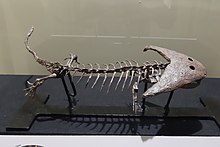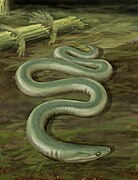Lepospondyli
| Lepospondyls Temporal range:
Late Permian[2] | |
|---|---|

| |
| Diplocaulus, a diplocaulid "nectridean" | |
| Scientific classification | |
| Domain: | Eukaryota |
| Kingdom: | Animalia |
| Phylum: | Chordata |
| Clade: | Sarcopterygii |
| Clade: | Tetrapodomorpha |
| Clade: | Stegocephali |
| Subclass: | †Lepospondyli Zittel, 1888 |
| Groups | |
|
Lissamphibia? Aïstopoda ?†Lysorophia †"Microsauria" †"Nectridea" | |
Lepospondyli is a diverse taxon of early tetrapods. With the exception of one late-surviving lepospondyl from the
Description
All lepospondyls are characterised by having simple, spool-shaped
Classification
The position of the Lepospondyli within the Tetrapoda is uncertain because the earliest lepospondyls were already highly specialized when they first appeared in the fossil record. Some lepospondyls were once thought to be related or perhaps ancestral to modern
However, a 1995 paper by Robert Carroll argued that lepospondyls were actually a monophyletic group closer to reptiles. Carroll considered them closer to reptiles than the seymouriamorphs, but not as close as the diadectomorphs.[15] Many phylogenetic analyses since Carroll (1995) agreed with his interpretation, including Laurin & Reisz (1997),[16] Anderson (2001),[17] and Ruta et al. (2003).[9] A few have still considered lepospondyls ancestral to amphibians, but came to this conclusion without changing the position of lepospondyls compared to seymouriamorphs and diadectomorphs.[8]
Lepospondyl and tetrapod classification is still controversial, and even recent studies have had doubts about lepospondyl monophyly. For example, a 2007 paper has suggested that adelospondyls are stem-tetrapods close to colosteids[3] and a 2017 paper on Lethiscus has Aïstopoda in the tetrapod stem based on their primitive braincase.[18] These studies differ in the internal and external relationships of the remaining lepospondyl taxa. The former places the remaining lepospondyls into a single clade along the amniote stem. The latter does not treat the relationships of nectrideans or adelospondyls, but finds microsaurs to be early amniotes, and places lysorophians within microsaurs.
Interrelationships
Five main groups of lepospondyls are often recognized:
|
Position within Tetrapoda
The "lepospondyl hypothesis" of modern amphibian origins proposes that lissamphibians are
Below is a cladogram from Ruta et al. (2003) that supports the "temnospondyl hypothesis", showing the position of Lepospondyli within crown group Tetrapoda:[9]
| Tetrapoda
|
| ||||||||||||||||||||||||||||||||||||||||||||||||||||||||||||||||||||||||||||||||||||||||||||||||||||||||||||
Gallery
-
microsaur"
-
microsaur"
-
microsaur"
-
microsaur"
-
aïstopod
-
aïstopod
References
- S2CID 84460890.
- ^ Anderson, J. S.; Kissel, R. A. (2002). "Lepospondyl diversity in the Early Permian and Late Pennsylvanian". Journal of Vertebrate Paleontology. 22 (3): 32A.
- ^ S2CID 86479890.
- S2CID 128605530.
- ^ Carroll, R. L. (1988) Vertebrate Paleontology and Evolution, WH Freeman & Co.
- S2CID 26700362.
- S2CID 12023942.
- ^ S2CID 67823991.
- ^ S2CID 31298396.
- ^ Jason D. Pardo, Matt Szostakiwskyj, Per E. Ahlberg & Jason S. Anderson (2017) Hidden morphological diversity among early tetrapods. Nature (advance online publication) doi:10.1038/nature22966>
- ^ a b Colbert 1969
- ^ Romer 1966
- ^ Carroll 1988
- ^ Benton 2000
- ^ Carroll, Robert L. (1995). "Problems of the phylogenetic analysis of Paleozoic choanates". Bulletin du Muséum National d'Histoire Naturelle, Section C. Series 4. 17 (1–4): 389–445.
- ^ Laurin, Michel; Reisz, Robert R. (1997). "Chapter 2: A new perspective on tetrapod phylogeny". In Sumida, S.; Martin, K. (eds.). Amniote origins—Completing the transition to land. London: Academic Press. pp. 9–59.
- PMID 12116927.
- S2CID 2478132.
- S2CID 85114894.
- .
- Benton, M. J.(2000), Vertebrate Paleontology, 2nd ed. Blackwell Science Ltd
- Benton, M. J. (2004), Vertebrate Paleontology, 3rd ed. Blackwell Science Ltd Taxonomic hierarchy
- Colbert, E H. (1969), Evolution of the Vertebrates, John Wiley & Sons Inc (2nd ed.)
- Laurin, Michel (1996) Terrestrial Vertebrates - Stegocephalians: Tetrapods and other digit-bearing vertebrates
- Romer, A.S., (1966) Vertebrate Paleontology University of Chicago Press, 1933; 3rd ed. 1966.










